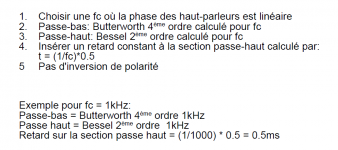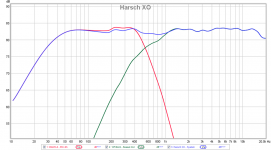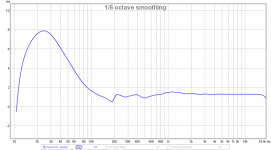It's been about 10 to 12 days for the orders from Aliexpress. They have a very good policy with DOA's or orders that don't arrive within 3 weeks. You keep it for no charge. They have an unbelievable ability to ship for free.
I haven't seen the equivalent Meanwell with dual rail and 50v at 400watts to 500watts. If you see something please send link.
These IRS2092 are made by Yuan Jing I think. It doesn't say but blue black color scheme is characteristic.
I haven't seen the equivalent Meanwell with dual rail and 50v at 400watts to 500watts. If you see something please send link.
These IRS2092 are made by Yuan Jing I think. It doesn't say but blue black color scheme is characteristic.
Last edited:
Hot tip from MMJ $20 for 900w dual rail supply.
Abletec 900 Watt Peak Class D Audio Amplifier Power Supply 53V DC UL Cul | eBay
Abletec 900 Watt Peak Class D Audio Amplifier Power Supply 53V DC UL Cul | eBay
The ampmodules are on Ebay too, little cheaper even.
Ebay customerservice does respond when you ask a question. Ali after a full refund turned evil and cost me around $50 manages to ignore all 45 tickets I made last 1.5 year asking them about their full refund policy that ended being more expensive than no refund. (after deducting a fee for unjust reason they managed to wire money back to me in a manner that was more expensive than the amount they transfered to me, with receiver paying costs for very expensive money transfer. The refund was asked for by seller that couldn't deliver ampboard)
Ebay customerservice does respond when you ask a question. Ali after a full refund turned evil and cost me around $50 manages to ignore all 45 tickets I made last 1.5 year asking them about their full refund policy that ended being more expensive than no refund. (after deducting a fee for unjust reason they managed to wire money back to me in a manner that was more expensive than the amount they transfered to me, with receiver paying costs for very expensive money transfer. The refund was asked for by seller that couldn't deliver ampboard)
Maybe my experience with Ali was dependent on the seller. It was tough getting a shopping identity established though on Ali - they kept canceling my orders for a while because they could not verify my identity for some reason. I think it was because they entered an incorrect zip code. I could not figure out until I called my CC company and they said Ali kept trying to put an order through with a bad zip code.
Hot tip from MMJ $20 for 900w dual rail supply.
Abletec 900 Watt Peak Class D Audio Amplifier Power Supply 53V DC UL Cul | eBay
Upon closer inspection this is only good for 1.4A sustained so maybe 150watts continuous?
Probably means you can power even high bias class A ???Upon closer inspection this is only good for 1.4A sustained so maybe 150watts continuous?
Sound Clips Comparing TPA3116D2 amp with TDA7492 Amp
Sound clips and measurements of the sound quality from a TPA3116 amp wit and without the new LC-filter Zobel mod, and TDA7492 amp (which has the built in Zobel circuit) as suggested by StanleyBurbick.
More technical details here:
http://www.diyaudio.com/forums/class-d/237086-tpa3116d2-amp-727.html#post4357821
Sound Clips here:
http://www.diyaudio.com/forums/class-d/237086-tpa3116d2-amp-727.html#post4357835
Blue is the TPA3116 and grey is the TDA7492:
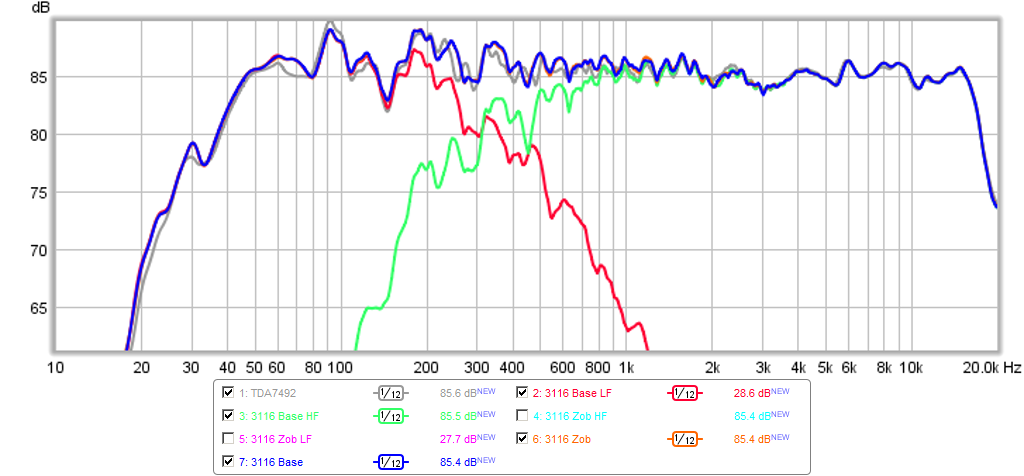
Here is the ne so-called LC filter Zobel mod (tiny SMT 10R and 0.1uF in series connecting the two legs of the input pins to the inductors):

Sound clips and measurements of the sound quality from a TPA3116 amp wit and without the new LC-filter Zobel mod, and TDA7492 amp (which has the built in Zobel circuit) as suggested by StanleyBurbick.
More technical details here:
http://www.diyaudio.com/forums/class-d/237086-tpa3116d2-amp-727.html#post4357821
Sound Clips here:
http://www.diyaudio.com/forums/class-d/237086-tpa3116d2-amp-727.html#post4357835
Blue is the TPA3116 and grey is the TDA7492:

Here is the ne so-called LC filter Zobel mod (tiny SMT 10R and 0.1uF in series connecting the two legs of the input pins to the inductors):

Last edited:
Probably means you can power even high bias class A ???
This 53v dual rail PS is available at PE for $20 free shipping for orders of $100 or more. It can sustain 4.1 amps for 5min which makes it a real contender as a supply for the IRS2092.
This 53v dual rail PS is available at PE for $20 free shipping for orders of $100 or more. It can sustain 4.1 amps for 5min which makes it a real contender as a supply for the IRS2092.
For europe PE might also be unatractive, although the PSU still looks cheap to me with added costs, UPS also bills you tax at delivery or by mail if they know you, it isn't a chinese company 🙂
Shipping Options
UPS - Worldwide Expedited (Excludes Duties/Tax)6/23/2015 23:30:00
$44.23
UPS Worldwide Saver (Excludes Duties/Tax)6/19/2015 23:30:00$56.51
DIY as a hobby is certainly cheapest in the U.S. for the availability of a lot of drivers and parts that one can often get with free shipping.
Are the shipping rates you show the eBay version or the PE version?
Are the shipping rates you show the eBay version or the PE version?
Ebay was >$60, those are PE options.
At $100/ch x 2 = $200 you should just get a COTS amp like Crown XLS1000 for circa $200.
Crown XLS 1000 XLS1000 Drivecore Stereo Power Amp | eBay
I'd check out Four Square audio on ebay too. New, very good prices, authorized retailer.
I believe Crown does have a 3yr transferable warrenty though, so used isn't such an issue
I believe Crown does have a 3yr transferable warrenty though, so used isn't such an issue
Without any comment about the quality just look at "Always the lowest price guarantee" official seller in my country, (euro is still a little more than a USdollar):
Crown XLS 1000 klasse D versterker met crossover kopen? | Goedkope | Promo | Versterker
Crown XLS 1000 klasse D versterker met crossover kopen? | Goedkope | Promo | Versterker
Without any comment about the quality just look at "Always the lowest price guarantee" official seller in my country, (euro is still a little more than a USdollar):
Crown XLS 1000 klasse D versterker met crossover kopen? | Goedkope | Promo | Versterker
Darn! Again, proves the US has cheap prices for DIY audio products. Maybe the $20 IRS2092 and $80 PS is not a bad choice.
Harsch Transient Perfect XO
This XO topology employing 4th order Bessel low pass for the woofer and 2nd order Butterworth high pass for the tweeter proposed by S. Harsch appears to be very interesting in its ability to produce an almost linear phase XO for transient perfect reproduction. The advantage is the steep 4th order on the woofer low pass that can suppress the cone break up on the woofer that causes the sound to not be "clean". I will try this soon and if it works, could be very cool. Thanks to Phaseaccurate for the tip!
http://petoindominique.fr/pdf/phase.pdf
If you can make out the French (easy since the technical stuff is universal) it says this:
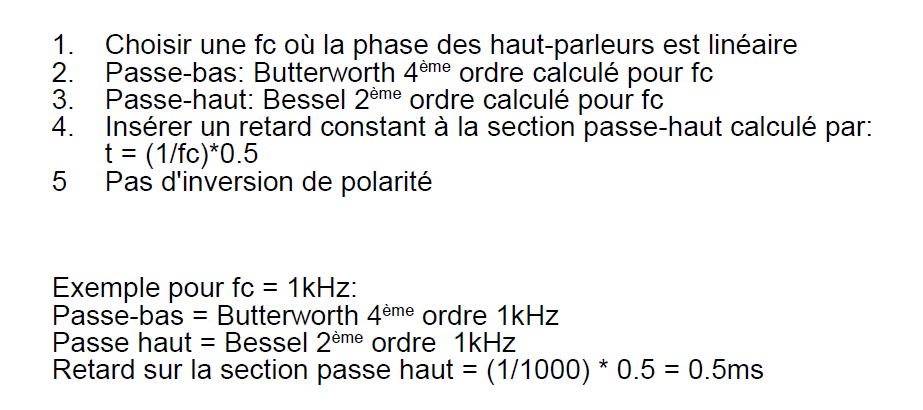
1. Choose XO freq fc
2. Set Butterworth 4th order low pass for woofer at fc
3. Set Bessel 2nd orde r high pass on tweeter at fc
4. Set delay equal to half cycle of fc
5. Invert polarity (on which? Or does pas mean do not?)
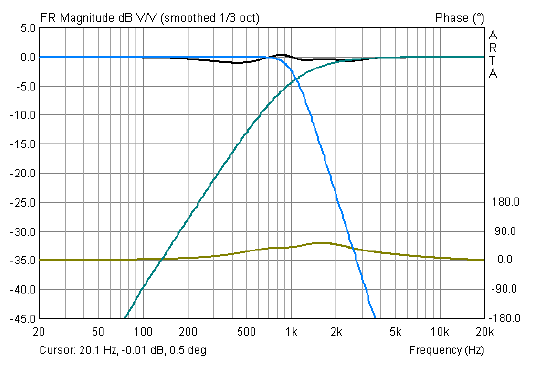
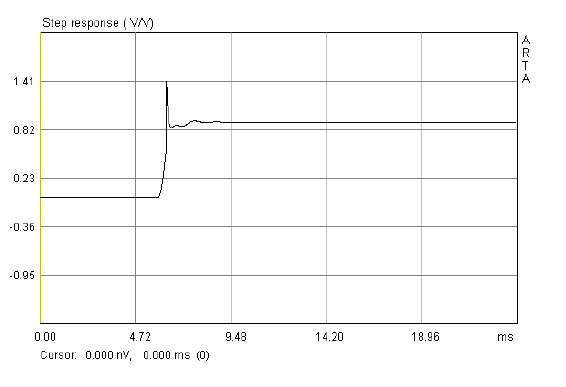
This XO topology employing 4th order Bessel low pass for the woofer and 2nd order Butterworth high pass for the tweeter proposed by S. Harsch appears to be very interesting in its ability to produce an almost linear phase XO for transient perfect reproduction. The advantage is the steep 4th order on the woofer low pass that can suppress the cone break up on the woofer that causes the sound to not be "clean". I will try this soon and if it works, could be very cool. Thanks to Phaseaccurate for the tip!
http://petoindominique.fr/pdf/phase.pdf
If you can make out the French (easy since the technical stuff is universal) it says this:

1. Choose XO freq fc
2. Set Butterworth 4th order low pass for woofer at fc
3. Set Bessel 2nd orde r high pass on tweeter at fc
4. Set delay equal to half cycle of fc
5. Invert polarity (on which? Or does pas mean do not?)


Attachments
Last edited:
Sim of Harsch XO using PCD
Since I had the FRD and ZMA files from my 10F/RS225 monitor already (SATX pulled them from manufacturer website for RS225 and from my measurement for 10F), I was able to put this into Jeff Bagby's excellent simulator program (Passive Crossover Designer or PCD) to test out the Samuel Harsch XO concept. I decided to use an electrical XO frequency fc=400Hz (requires a delay of 1.25ms on tweeter). I had to apply a few very minor PEQ's to flatten things (shown below), but the overall sim looks very promising.
Here are the PEQ's used:
Crossover filter settings per Harsch recommendation:
Woofer is Low Pass Butterworth 4th order at 400Hz
Mid/Tweeter is High Pass Bessel 2nd order at 400Hz with 1.25ms delay relative to woofer.
Here is the resulting modeled XO response:

Here is the predicted group delay (notice the relatively flat GD through the XO region):
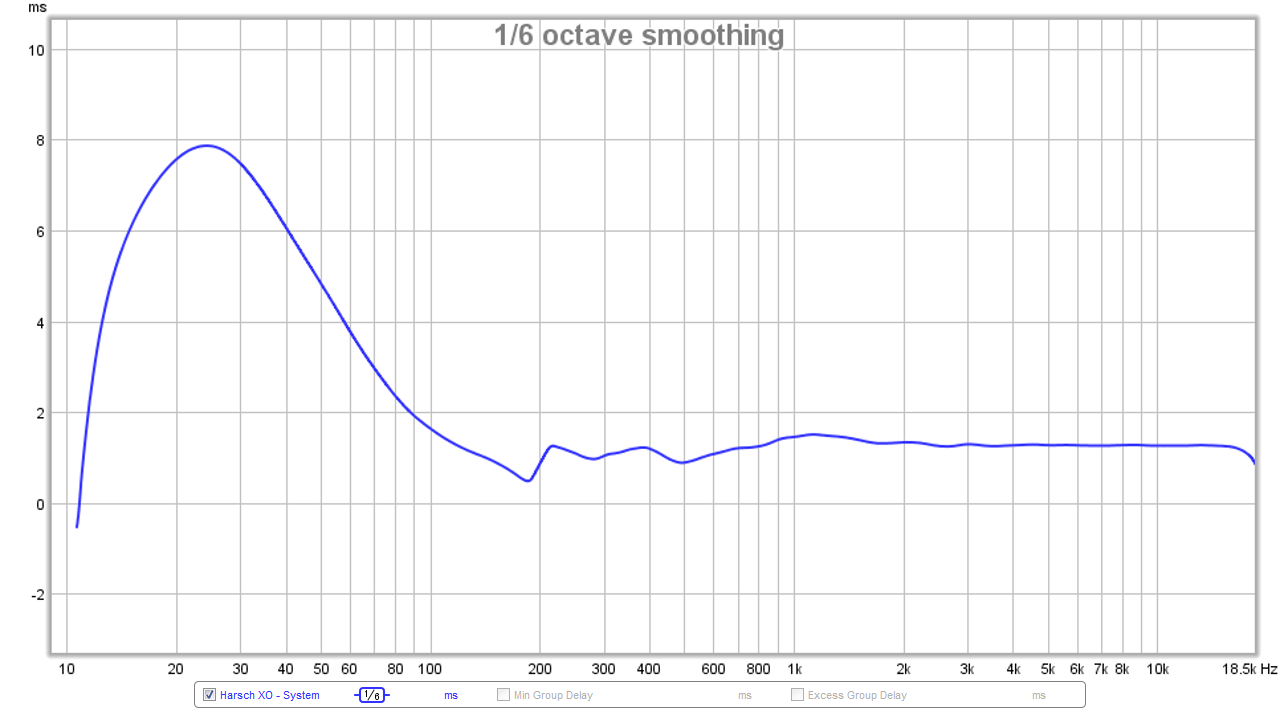
Next step is to try this in real life...
Although electrical xo freq was 400Hz, the acoustical xo appears to be about 550Hz. So the natural response of the speakers may call for asymmetric xo frequencies. This may help reduce the dip at the xo region because it is too wide now.
Since I had the FRD and ZMA files from my 10F/RS225 monitor already (SATX pulled them from manufacturer website for RS225 and from my measurement for 10F), I was able to put this into Jeff Bagby's excellent simulator program (Passive Crossover Designer or PCD) to test out the Samuel Harsch XO concept. I decided to use an electrical XO frequency fc=400Hz (requires a delay of 1.25ms on tweeter). I had to apply a few very minor PEQ's to flatten things (shown below), but the overall sim looks very promising.
Here are the PEQ's used:
Code:
Woofer: -2.5dB @300Hz, Q=1
Mid/Tweeter: -1dB @1000Hz, Q=1, -1.8dB @10kHz, Q=1 and overall padding of -6.0dBCrossover filter settings per Harsch recommendation:
Woofer is Low Pass Butterworth 4th order at 400Hz
Mid/Tweeter is High Pass Bessel 2nd order at 400Hz with 1.25ms delay relative to woofer.
Here is the resulting modeled XO response:

Here is the predicted group delay (notice the relatively flat GD through the XO region):

Next step is to try this in real life...
Although electrical xo freq was 400Hz, the acoustical xo appears to be about 550Hz. So the natural response of the speakers may call for asymmetric xo frequencies. This may help reduce the dip at the xo region because it is too wide now.
Attachments
Last edited:
1. Choose XO freq fc
2. Set Butterworth 4th order low pass for woofer at fc
3. Set Bessel 2nd orde r high pass on tweeter at fc
4. Set delay equal to half cycle of fc
5. Invert polarity (on which? Or does pas mean do not?)
It means "do not invert polarit" witch can be seen on the step response.
That's pretty cool. I tend to like asymmetrical crossovers for pro type speakers or wherever a steeper slop is required, and often suspected they could be "quasi optimal" transient pretty good if done well, based on what i heard. Nice to see some more extensive data.
One thing that always gets me is that the textbook slopes of these more esoteric XO's are generally hard to achieve in reality as the response of the driver, the enclosure, etc modify it. So just picking an electrical 4th order Butterworth for example, is only half the story. Generally, I have a hard time achieving true 6dB/oct fall off for a 1st order. Until the acoustic (measured) XO slopes match the textbook example, the sim will be off and you get a different behavior. Then you have to try to use some mile PEQ'ing to shape the response to the textbook shape.
- Home
- Loudspeakers
- Full Range
- 10F/8424 & RS225-8 FAST / WAW Ref Monitor
